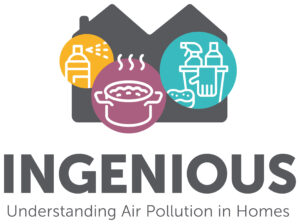Many of the activities we do in our own homes produce airborne pollutants, including particles and chemicals that can be harmful to our health. We don’t know exactly where all of these pollutants come from, how they interact with each other or where they end up. The INGENIOUS project will investigate these unknowns and deliver useful interventions to limit exposure. It focuses on homes in the city of Bradford, UK.
2021–2025
Bradford City Hall and Centenary Square at night. Photo: Kelvinjay / Getty Images.
UK residents spend around 90% of their time indoors, yet regulations to address air pollution focus almost solely on outdoor exposure. Indoor air pollution takes many forms, from particulate matter such as dust and soot from wood burners to gases like carbon monoxide from gas stoves. Breathing in these particles and gases are bad for our health and poor indoor air quality has been linked to lung diseases including asthma, cancer and chronic obstructive pulmonary disease.
SEI is taking part in a £2.9 million UK Research and Innovation (UKRI) project to better understand how the composition and concentration of indoor air pollutants vary and how this exposure affects people in their homes.
The project will focus on homes in the city of Bradford, which, like many other parts of the UK, is affected by poor air quality. Bradford has a multi-ethnic population and high levels of deprivation, with some of the highest childhood illness rates in the UK.
Watch a short animation introducing the project
To view this content, please enable experience cookies for videos, podcasts and other media.
Visit our cookie policy to learn more and update your preferences.
This animation introduces the project and explains what is involved for participants. Production: Digifish.
A team of scientists from four universities, including SEI York based at the University of York, will work with the Bradford Teaching Hospital NHS Foundation Trust and Born In Bradford study – a long-term research programme following children born in the city – to better understand the potential impacts of poor indoor air quality on ill health.
The team will quantify and identify:

Aerial view of Bradford city centre, Yorkshire, UK. Photo: SAKhanPhotography / Getty Images.
SEI York’s contribution will focus on the co-production and evaluation of behaviour change interventions and the development of policy recommendations. To do this, SEI will communicate with homeowners, tenants and communities about the risks associated with indoor air pollution exposure and the actions they can take to reduce their exposure.
SEI will also work with local authorities, planners and developers to identify suitable policy recommendations for addressing this issue in homes across the city and provide a blueprint for applying these measures in homes and businesses across the UK.
“This study is the first of its kind to look in such detail at the pollution inside people’s homes in the UK, particularly focusing on poorer households. At SEI, we will be using our strengths in policy engagement and citizen science to work with decision-makers and local residents to identify how householders and local authorities can reduce exposure to air pollution in the home.
Once we have examined the different behaviours that influence a person’s exposure to indoor air pollution, for example, using fans whilst cooking or opening windows to increase ventilation, we will then provide advice to householders and local authorities on the changes they can make to improve air quality in the home.”
– Dr Sarah West, who is leading SEI’s contribution to the study

INGENIOUS project logo: Aninna Diston.

This project is funded by the UKRI Strategic Priorities Fund Clean Air Programme.
The £2.9 million project brings together specialists in environmental, social, medical, engineering, economic, and health issues.
The project is led by Professor Nicola Carslaw at the University of York, Department of Environment and Geography.
Feature / At the INGENIOUS webinar, Sarah West and indoor air quality experts emphasized the need for further research to promote indoor air quality in all UK households.
20 February 2024 / About Pollution
Past event / The INGENIOUS project invited the public and key stakeholders to a knowledge exchange webinar on indoor air pollutants in the UK housing sector.
16 February 2024 / About Cities, Pollution and Short lived climate pollutants
Perspective / Improving indoor air quality remains a global issue that requires collective action.
11 September 2023 / About Household energy, Pollution and Short lived climate pollutants
Feature / SEI York Centre Director Sarah West was interviewed for a recent briefing for the UK parliament.
10 October 2023 / About Pollution, Public policy and Wellbeing
Feature / The 2023 edition, with the theme, “Together for Clean Air", emphasizes the urgent need for stronger partnerships and shared responsibility.
7 September 2023 / About Cities, Food and agriculture, Household energy, Pollution, Short lived climate pollutants and Transport
Feature / Air pollution is a central research topic at SEI. This Clean Air Day UK, explore our latest research including monitoring indoor air in UK schools and homes.
12 June 2023 / About Pollution and Short lived climate pollutants
Project / A citizen science project monitoring indoor air, created with and for UK schools.
Project / Air pollution is a serious threat to the health of humans and ecosystems, yet is largely invisible and so out of the public consciousness.
2017 / About Cities, Participation, Pollution, Short lived climate pollutants and Wellbeing
Journal article / This paper addressed how poor ventilation and polluting cooking fuels in low-income homes cause high exposure, yet relevant global studies remain limited.
Design and development by Soapbox.